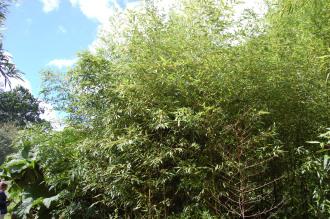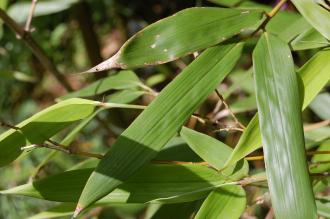
Phyllostachys flexuosa (28/07/2014, Botanique National de Brest, France)
Position: Sun to light shade
Flowering Period: N/A
Soil: Moist, well drained
Eventual Height: 6m
Eventual Spread: 2m
Hardiness: 6b, 7a, 7b, 8a, 8b, 9a, 9b
Family: Poaceae
Phyllostachys flexuosa is an evergreen, running bamboo with a spreading, arching habit. Its mid green leaves are linear with entire margins and are up to 15cm long and 2cm broad. Its yellow/ green culms are slightly wavy, mature to dark green and are up to 4cm in diameter. Its culm sheaths are brown in color. This plant spreads by underground rhizomes.

Phyllostachys flexuosa Leaf (28/07/2014, Botanique National de Brest, France)
Phyllostachys flexuosa, commonly known as Sinuate Bamboo or Qiuganzhu, is native to China. In its native habitat it grows in monotypic stands of bamboo forest.
The etymological root of the binomial name Phyllostachys is derived from the Greek phyllon meaning ‘leaf’ and stachys meaning ‘spike’. Flexuosa is from the Latin flexuosus meaning ‘ with many curves’.
The landscape architect may find Phyllostachys flexuosa useful as a useful as a screening hedging plant that is low maintenance. Caution must be exercised when specifying this plant due to its potentially invasive nature. A root barrier may be used to contain its spread.
Ecologically, Phyllostachys flexuosa is of little wildlife value in the UK.

Phyllostachys flexuosa Stem (28/07/2014, Botanique National de Brest, France)
Phyllostachys flexuosa prefers moist, humus rich, well-drained soils. It tolerates most pH of soil.
Phyllostachys flexuosa requires little to no maintenance. A root barrier may be installed at the time of planting to restrict the spread of this plant. The plant may be thinned out of required and spent canes may be cut back to the ground level.

